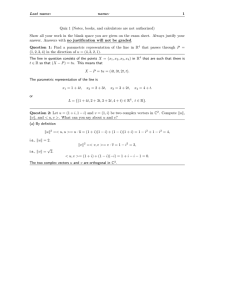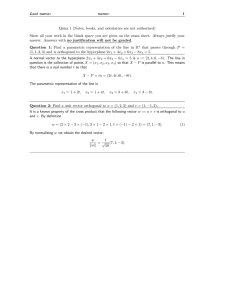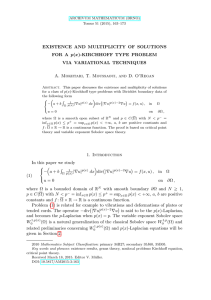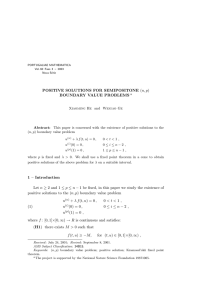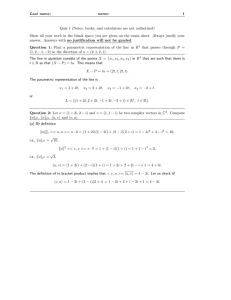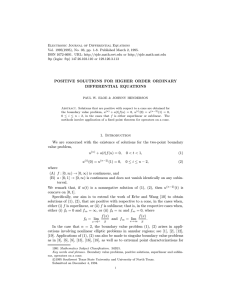Memoirs on Differential Equations and Mathematical Physics VALUE PROBLEM
advertisement
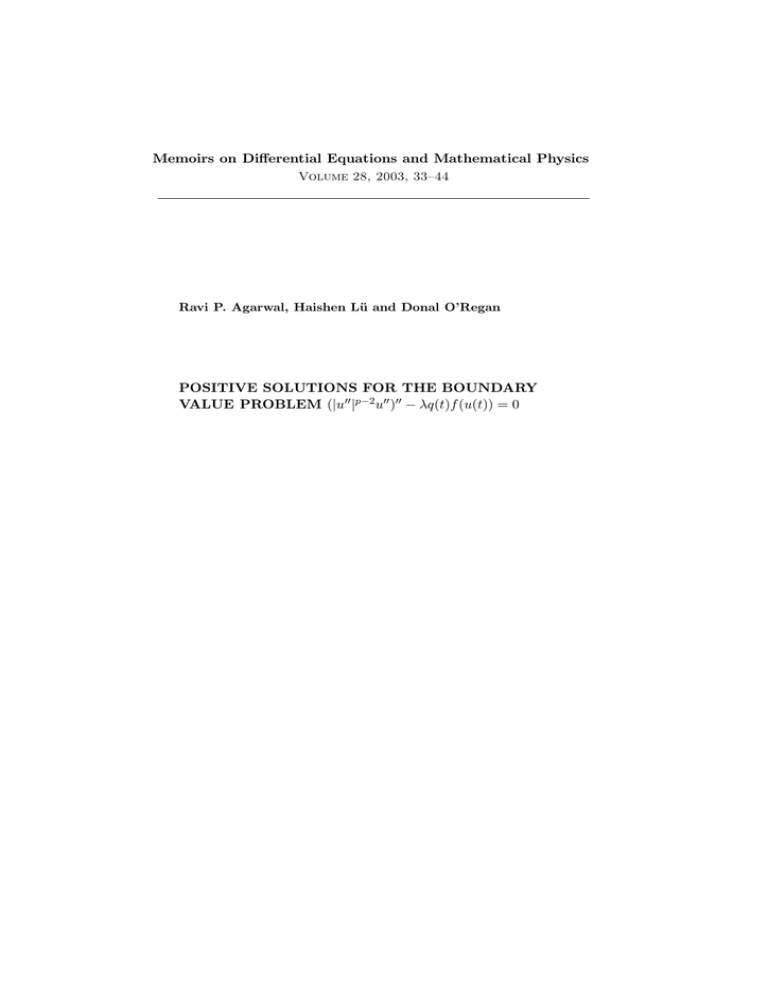
Memoirs on Differential Equations and Mathematical Physics
Volume 28, 2003, 33–44
Ravi P. Agarwal, Haishen Lü and Donal O’Regan
POSITIVE SOLUTIONS FOR THE BOUNDARY
VALUE PROBLEM (|u00 |p−2 u00 )00 − λq(t)f (u(t)) = 0
Abstract. This paper considers the boundary value problem:
( 00
p−2 00
|u00 |
u
− λq(t)f (u (t)) = 0, in (0, 1) ,
u(0) = u(1) = u00 (0) = u00 (1) = 0,
with λ > 0. The value of λ is chosen so that the boundary value problem has
a positive solution. Moreover, we derive an explicit interval for λ such that
for any λ in this interval, the existence of a positive solution to the boundary
value problem is guaranteed. In addition we also discuss the existence of
two positive solutions for λ in an appropriate interval.
2000 Mathematics Subject Classification. 34B15.
Key words and phrases: Boundary value problem, Positive solution,
Beam equation.
00
"!
|u00 |p−2 u00 − λq(t)f (u (t)) = 0, (0, 1) − ,
u(0) = u(1) = u00 (0) = u00 (1) = 0,
! & ! ! ' ! ( ) * λ+>
, 0 $λ
% .- / #! #, () # , + + +! & ( # # #! &
$ ! + + 1 2 !
&
!
&
0
!
λ%
# #! & +3 ! & & 0 ! & $ ' ! ! + ! %
+4.# #! & + 3 ! & & 5 + $
35
POSITIVE SOLUTIONS
1. Introduction
This paper studies the two-point boundary value problem
00
(ϕp (u00 )) − λq (t) f (u (t)) = 0, t ∈ (0, 1)
u (0) = u (1) = u00 (0) = u00 (1) = 0
(1.1)
p−1
where ϕp (s) = |s|
s, and p > 1.
Equations of the above form (1.1) occur in beam theory [1], for example,
1. a beam with small deformations (also called geometric linearity);
2. a beam of a material which satisfies a nonlinear power-like stress -strain
law;
3. a beam with two-sided links (for example, springs) which satisfies a
nonlinear power-like elasticity law.
The best known setting is the boundary value problem when p = 2,
namely
u(4) − q (t) f (u (t)) = 0, t ∈ (0, 1) .
This equation arises when one describes deformations of an elastic beam.
Usually both ends are simply supported, or one end is simply supported
and the other end is clamped by sliding clamps. Also vanishing moments
and shear forces at the beam ends are frequently included in the boundary
conditions; see Gupta [2] and Yang [5] . One derivation of this fourth order
equation plus the two-point boundary conditions occurs when the method
of lines is used in the description over regions of certain partial differential
equations describing the deflection of an elastic beam.
Closely related to the results of this paper is the recent work by Ma and
Wang [4] . In [4] the authors establish the existence of at least one positive
solution of the above fourth order equation for p = 2 satisfying the boundary
value conditions, when the nonlinearity f is superlinear and sublinear.
Singular nonlinear two-point boundary value problem arise naturally
in applications and usually, only positive solutions are meaningful. By
a positive solution of (1.1), we mean a function u ∈ C 2 ([0, 1] , R) with
ϕp (u00 ) ∈ C 2 ((0, 1) , R) satisfying (1.1) , and with u nonnegative and not
identically zero on [0, 1] . If, for a particular λ the boundary value problem
(1.1) has a positive solution u, then λ is called an eigenvalue and u a corresponding eigenfunction of (1.1) . The set of eigenvalues of (1.1) will be
denoted by E, i.e.,
E = {λ > 0 | (1.1) − (1.2) has a positive solution } .
In section 2, some preliminary results are presented. Section 3 presents
explicit eigenvalue intervals in terms of f0 and f∞ , where
f0 = lim+
x→0
f (x)
f (x)
and f∞ = lim p−1 .
x→∞ x
xp−1
Finally, we state a fixed point theorem due to Krasnosel’skii which will
be needed in this paper.
36
Ravi P. Agarwal, Haishen Lü and Donal O’Regan
Theorem 1.1. Let X be a Banach space, and let K(⊂ X) be a cone.
Assume Ω1 , Ω2 are open subsets of X with 0 ∈ Ω1 , Ω1 ⊂ Ω2 , and let
T : K ∩ Ω2 \Ω1 → K
be a completely continuous operator such that, either
(a) kT uk ≤ kuk , u ∈ K ∩ ∂Ω1 , and kT uk ≥ kuk , u ∈ K ∩ ∂Ω2 , or
(b) kT uk ≥ kuk , u ∈ K ∩ ∂Ω1 , and kT uk ≤ kuk , u ∈ K ∩ ∂Ω2 .
Then, T has a fixed point in K ∩ Ω2 \Ω1 .
2. Preliminary Results
Throughout this paper, it is assumed that f : [0, ∞) → [0, ∞) is continuous and that the following condition is satisfied:
R1
(H1) q ∈ C (0, 1) is nonnegative with 0 t (1− t) q (t) dt < ∞ and there
1 m−1
, m with q (c) > 0.
exist a natural number m ≥ 3 and c ∈ m
Let X = (C [0, 1] , k·k) ( here kuk = supt∈[0,1] |u (t)| , u ∈ C [0, 1] ) be our
Banach space and
o
n
1
K = u ∈ C [0, 1] | u(t) ≥ 0 for t ∈ [0, 1] and
min
u(t)
≥
k
uk
,
1
1
m
t∈[ m
,1− m
]
Kr = {u ∈ K : kuk < r} and ∂Kr = {u ∈ K : kuk = r} .
Let G (t, s) be the Green’s function for
00
u = 0, 0 ≤ t ≤ 1,
u (0) = u (1) = 0.
Then
G (t, s) =
Let
A1 = max
0≤t≤1
and
A2 =
min
Z
1/m≤t≤1−1/m
(1 − t) s, 0 ≤ s ≤ t ≤ 1,
(1 − s) t, 0 ≤ t ≤ s ≤ 1.
1
G (t, s) ϕ−1
p
0
Z
Z
1
0
G (t, s) ϕ−1
p
1
0
Z
G (s, x) q (x) dx ds,
1−1/m
!
G (s, x) q (x) dx ds.
1/m
1
p−1
where ϕ−1
s is an inverse function of ϕp . It is easy to see that
p (s) = |s|
0 < A1 < ∞ and 0 < A2 < ∞.
Define T, H : X → X by
Z 1
(T u) (s) =
λG (x, s) q (x) f (u (x)) dx
(2.1)
0
and
(Hu) (t) =
Z
1
0
Lemma 2.1. H(T (K)) ⊂ K.
G (t, s) ϕ−1
p (u (s)) ds.
(2.2)
37
POSITIVE SOLUTIONS
Proof. A direct calculation shows that
G (t, s) ≤ G (s, s) , for 0 ≤ t ≤ 1 and 0 ≤ s ≤ 1,
(2.3)
and
1
1
1
G (s, s) , for
≤t≤1−
and 0 ≤ s ≤ 1.
(2.4)
m
m
m
From (2.3), we obtain
Z 1
Z 1
(H (T u)) (t) =
G (t, x) ϕ−1
λG(x,
s)q(s)f
(u(s))ds
dx
p
G (t, s) ≥
0
≤
Thus
kH (T u)k ≤
Finally notice
Z
0
1
G (x, x) ϕp−1
0
1
0
G (x, x) ϕ−1
p
min
(H (T u)) (t)
min
1
Z
1
1
t∈[ m
,1− m
]
=
Z
1
t∈[ m ,1− m
]
1
1
0
G (t, x) ϕ−1
p
1
Z
1
λG(x, s)q(s)f (u(s))ds dx.
0
1
λG(x, s)q(s)f (u(s))ds dx.
0
Z
1
0
λG(x, s)q(s)f (u(s))ds dx
1
−1
≥
G (x, x) ϕp
λG(x, s)q(s)f (u(s))ds dx
m 0
0
1
≥
kHT uk .
m
Remark 1. We can easily prove that T (K) ⊂ K and that H(K) ⊂ K.
Z
Z
Z
Lemma 2.2. HT : K → K is completely continuous.
Proof. We first prove T : K → K is completely continuous.
For n = 1, 2, . . . , let qn (t) = min {q (t) , n}, and en = {t ∈ [0, 1] | q (t) ≥
n}. Let
Z 1
λG (s, x) qn (x) f (u (x)) dx.
(Tn u) (s) =
0
It is easy to see [4] that Tn : K → K is completely continuous, for n ∈ N =
{1, 2, · · · }. By (H1) , we have
Z
lim
t (1 − t) q (t) = 0.
n→∞
en
For ∀R > 0 and ∀u ∈ K R , with M = max0≤x≤R f (x) , we have
kT u − Tn uk = max |(T u) (t) − (Tn u) (t)|
0≤t≤1
Z
= λ max
G (x, t) (q (x) − n) f (u (x)) dx
0≤t≤1
en
38
Ravi P. Agarwal, Haishen Lü and Donal O’Regan
Z
≤ λM max
G (x, t) q (x) dx
0≤t≤1 e
n
Z
x (1 − x) q (x) dx → 0, (n → ∞) ,
≤ λM
en
so sup kT u − Tn uk : u ∈ K R → 0, as n → ∞. Therefore, T : K → K
is completely continuous. Also it is easy to prove that H : K → K is
completely continuous. Consequently, HT : K → K is completely continuous.
3. Eigenvalue Intervals
Theorem 3.1. Suppose that (H1) holds. Then, (1.1) has at least one
positive solution for each
ϕp (m)
1
,
;
(3.1)
λ∈
f∞ ϕp (A2 ) f0 ϕp (A1 )
here m is chosen as in (H1) .
Proof. Let λ satisfy (3.1) and let ε > 0 be such that
1
ϕp (m)
≤λ≤
(f∞ − ε)ϕp (A2 )
(f0 + ε)ϕp (A1 )
(3.2)
Next, we pick r > 0 so that
f (x) ≤ (f0 + ε)xp−1 , 0 < x ≤ r.
(3.3)
Let u ∈ ∂Kr . We find that for t ∈ [0, 1] ,
Z 1
Z 1
−1
(H(T u)) (t) =
G (t, x) ϕp
λG(x, s)q(s)f (u(s))ds dx
0
≤
Z
0
1
G (t, x) ϕ−1
p
0
Z
1
1
≤ λ p−1 (f0 + ε) p−1 r
≤ rA1 λ
1
p−1
(f0 + ε)
1
λG(x, s)q(s)(f0 + ε)u
0
Z
1
0
1
p−1
G (t, x) ϕ−1
p
Z
1
0
p−1
(s)ds dx
G(x, s)q(s)ds dx
≤ r = kuk .
Hence,
kHT uk ≤ kuk , for u ∈ ∂Kr .
(3.4)
If we set Ω1 = {u ∈ X : kuk < r} , then (3.4) holds for u ∈ K ∩ ∂Ω1 .
Let R1 > 0 be such that
f (x) ≥ (f∞ − ε) xp−1 , x ≥ R1 .
(3.5)
Let u ∈ K be such that
= R := max {2r, mR1 } ; here m is chosen as in
1 kuk
(H1) . Then, for t ∈ m
, m−1
,
m
u (t) ≥
1
1
kuk ≥
· mR1 = R1 ,
m
m
39
POSITIVE SOLUTIONS
which in view of (3.5) leads to
f (u (t)) ≥ (f∞ − ε) u
p−1
1 m−1
(t) , t ∈
,
.
m
m
1
1
Consequently ( here c ∈ m
,1− m
is chosen as in (H1) ),
Z 1
Z 1
−1
(H(T u)) (c) =
G (c, x) ϕp
λG(x, s)q(s)f (u(s))ds dx
0
≥
Z
0
1
G (c, x) ϕ−1
p
0
≥λ
1
p−1
(3.6)
(f0 − ε)
1
p−1
Z
m−1
m
λG(x, s)q(s) (f∞ − ε) u
p−1
(s)ds dx
1
m
R
·
·
m
Z
1
0
G (c, x) ϕ−1
p
1
1
R
· A2 λ p−1 (f0 − ε) p−1
m
≥ R = kuk .
Z
!
!
m−1
m
G(x, s)q(s)ds dx
1
m
≥
Therefore,
kHT uk ≥ kuk , for u ∈ ∂KR .
(3.7)
If we set Ω2 = {u ∈ X : kuk < R} , then (3.7) holds for u ∈ K ∩ ∂Ω2 .
Now (3.4), (3.7) , and Theorem 1.1 guarantee that HT has a fixed point
u ∈ K ∩ (Ω2 \Ω1 ) with r ≤ kuk ≤ R. Clearly, this u is a positive solution of
(1.1) .
Theorem 3.2. Suppose that (H1) holds. Then (1.1) has at least one
positive solution for each
1
ϕp (m)
λ∈
,
;
(3.8)
f0 ϕp (A2 ) f∞ ϕp (A1 )
here m is chosen as in (H1) .
Proof. Let λ satisfy (3.8) and let ε > 0 be such that
ϕp (m)
1
≤λ≤
.
(f0 − ε)ϕp (A2 )
(f∞ + ε)ϕp (A1 )
(3.9)
Choose r > 0 so that
f (x) ≥ (f0 − ε) xp−1 , 0 < x ≤ r.
1
m
Now, let u ∈ K be such that kuk = r. Then, u (t) ≥ kuk for t ∈
Then (3.10) guarantees ( here c is as in (H1) ),
Z 1
Z 1
(H(T u)) (c) =
G (c, x) ϕ−1
λG(x,
s)q(s)f
(u(s))ds
dx
p
0
≥
Z
1
0
G (c, x) ϕ−1
p
1
(3.10)
.
m−1
m, m
0
Z
m−1
m
λG(x, s)q(s) (f∞ − ε) u
1
m
p−1
!
(s)ds dx
40
Ravi P. Agarwal, Haishen Lü and Donal O’Regan
≥λ
1
p−1
(f0 − ε)
r
·
·
m
1
p−1
Z
1
Z
G (c, x) ϕ−1
p
0
1
1
r
· A2 λ p−1 (f0 − ε) p−1
m
≥ r = kuk .
!
m−1
m
G(x, s)q(s)ds dx
1
m
≥
Therefore,
kHT uk ≥ kuk , for u ∈ ∂Kr .
Next, we may choose R2 > 0 such that
(3.11)
f (x) ≤ (f∞ + ε)xp−1 , x ≥ R2 .
(3.12)
Here there are two cases to consider, namely, f bounded and f unbounded.
Case 1. Suppose that f is bounded. Then, there exists some M > 0
with
f (x) ≤ M, x ∈ (0, ∞) .
(3.13)
We define
n
o
1
R = max 2r, (λM ) p−1 A1 .
Let y ∈ K be such that kyk = R. For t ∈ [0, 1], from (3.12) we have
Z 1
Z 1
(H(T u)) (t) =
G (t, x) ϕ−1
λG(x,
s)q(s)f
(u(s))ds
dx
p
0
≤
Z
0
1
G (t, x) ϕ−1
p
0
=λ
1
p−1
M
1
p−1
1
Z
1
Z
1
0
λG(x, s)q(s)M ds dx
G (t, x) ϕ−1
p
0
1
Z
1
G(x, s)q(s)ds dx
0
≤ A1 λ p−1 M p−1
≤ R = kuk .
Hence,
kHT uk ≤ kuk , for u ∈ ∂KR .
(3.14)
Case 2. Suppose that f is unbounded. Then, there exists R ≥
max {2r, R2 } such that
f (x) ≤ f (R) , 0 < x ≤ R.
(3.15)
Let y ∈ K be such that kyk = R. Then, (3.15) yields for t ∈ [0, 1] that
Z 1
Z 1
−1
(H(T u)) (t) =
G (t, x) ϕp
λG(x, s)q(s)f (u(s))ds dx
0
≤
Z
0
1
G (t, x) ϕ−1
p
0
1
1
= λ p−1 f (R) p−1
≤ A1 λ
1
p−1
Z
Z
1
λG(x, s)q(s)f (R) ds dx
0
1
0
(f∞ + ε)
G (t, x) ϕ−1
p
1
p−1
R
Z
1
0
G(x, s)q(s)ds dx
41
POSITIVE SOLUTIONS
≤ R = kuk .
Thus (3.14) is true also in this case.
In both cases, if we set Ω2 = {u ∈ K : kuk < R} , then (3.14) holds for
u ∈ K ∩ ∂Ω2 .
If we set Ω1 = {u ∈ X : kuk < r} , then (3.11) holds for u ∈ K ∩ ∂Ω1 .
Now that we have obtained (3.11) and (3.14)
, it follows from Theorem
1.1 that HT has a fixed point u ∈ K ∩ Ω2 \Ω1 such that r ≤ kuk ≤ R. It
is clear that u is a positive solution of (1.1) .
Let
(L1) f0 = ∞, (L2) f∞ = ∞, (L3) f0 = 0, and (L4) f∞ = 0. Corollary 3.1. Suppose that (H1) holds. In addition, assume one of
the following conditions hold: (1) (L1) and (L4); (2) (L2) and (L3). Then
we conclude from Theorem 3.1 and 3.2 that E = (0, ∞) , i.e., (1.1) has a
positive solution for any λ > 0.
Theorem 3.3. Suppose that (H1) holds. In addition assume there exist
two constants R > r > 0, such that
max f (y) ≤ ϕp (r/A1 )/λ,
0≤y≤r
min
γR≤y≤R
f (y) ≥ ϕp (R/A2 )/λ;
1
, and m is as in (H1) . Then, (1.1) has a solution u ∈ K with
here γ = m
r ≤ kuk ≤ R.
Proof. For u ∈ ∂Kr , we have that f (u(t)) ≤ ϕp (r/A1 )/λ, for t ∈ [0, 1]. Then
Z 1
Z 1
(H(T u)) (t) =
G (t, x) ϕ−1
λG(x,
s)q(s)f
(u(s))ds
dx
p
0
≤
Z
0
1
0
G (t, x) ϕ−1
p
= r/A1 ·
Z
1
0
Z
1
0
λG(x, s)q(s)ϕp (r/A1 )/λds dx
G (t, x) ϕ−1
p
≤ r = kuk .
Z
1
G(x, s)q(s)ds dx
0
As a result kHT uk ≤ kuk , for ∀u ∈ ∂Kr .
1 m−1 , m .
For u ∈ ∂KR , we have that f ((u(t)) ≥ ϕp (R/A2 )/λ, for t ∈ m
Then, with c as in (H1) ,
Z 1
Z 1
−1
(H(T u)) (c) =
G (c, x) ϕp
λG(x, s)q(s)f (u(s))ds dx
0
0
!
Z
Z m−1
1
≥
0
G (c, x) ϕ−1
p
= R/A2 ·
Z
m
1
m
1
0
≥ R = kuk .
G (c, x) ϕ−1
p
λG(x, s)q(s)ϕp (R/A2 )/λds dx
Z
m−1
m
!
G(x, s)q(s)ds dx
1
m
42
Ravi P. Agarwal, Haishen Lü and Donal O’Regan
Therefore,
kHT uk ≥ kuk , for u ∈ ∂KR .
(3.16)
It follows from Theorem 1.1 that HT has a fixed point in K r,R .
Next we need the following condition:
(H2) There exist a constant ρn with limn→∞ ρn = 0 and f (ρn ) > 0, for
n = 1, 2, . . . .
Let
ϕp (r/A1 )
λ∗ = sup
max
r>0
0≤y≤r f (y)
We easily obtain that 0 < λ∗ ≤ ∞ using (H2) .
Theorem 3.4. Suppose (H1) , (H2) , (L1) and (L2) hold. Then (1.1) has
at least two nontrivial positive solutions for all λ ∈ (0, λ∗ ) .
ϕ (r/A )
p
1
Proof. Define h(r) = max0≤x≤r
f (x) . Using conditions (H2) , (L1) and (L2) ,
we easily obtain that h : (0, ∞) → (0, ∞) is continuous and lim r→0 h (r) =
limr→∞ h (r) = 0. There exists r0 ∈ (0, +∞) such that h (r0 ) = supr>0 h (r) =
λ∗ . For λ ∈ (0, λ∗ ) , there exist constants c1 , c2 (0 < c1 < r0 < c2 < ∞) ,
such that h (c1 ) = h (c2 ) = λ.
As a result
f (y) ≤ ϕp (c1 /A1 )/λ, for y ∈ [0, c1 ],
and
f (y) ≤ ϕp (c2 /A1 )/λ, for y ∈ [0, c2 ].
On the other hand, using conditions (L1) and (L2) , there exist constants
d1 , d2 (0 < d1 < c1 < c2 < d2 < ∞) such that
1
1
f (y)
≥ ϕp
, y ∈ (0, d1 ) ∪ (γd2 , +∞),
y p−1
λ
γA2
and so,
min
γd1 ≤y≤d1
f (y) ≥ ϕp (d1 /A2 )/λ,
min
γd2 ≤y≤d2
f (y) ≥ ϕp (d2 /A2 )/λ.
Theorem 3.5. Suppose (H1) and (H2) hold. Assume either (L1) or
(L2) hold. Then (1.1) has at least one positive solution for all λ ∈ (0, λ ∗ ) .
Next we need the following condition:
1
(H3) minr>0 supγr≤y≤r f (y) > 0, here γ = m
.
Let
ϕp (r/A2 )
λ∗∗ = inf
.
r>0 minγr≤y≤r f (y)
We easily obtain that 0 ≤ λ∗∗ < ∞ using (H3) .
Theorem 3.6. Suppose (H1) , (H3) , (L3) and (L4) hold. Then (1.1)
has at least two nontrivial positive solutions for all λ ∈ (λ∗∗ , ∞) .
43
POSITIVE SOLUTIONS
ϕ (r/A )
p
2
Proof. Define p(r) = minγr≤x≤r
f (x) . Using conditions (H3) , (L3) and (L4) ,
we easily obtain that p : (0, ∞) → (0, ∞) is continuous and lim r→0 p (r) =
limr→∞ p (r) = ∞. There exists r0 ∈ (0, +∞) such that p (r0 ) = inf r>0 p (r) =
λ∗∗ . For λ ∈ (λ∗∗ , ∞) , there exist constants d1 , d2 (0 < d1 < r0 < d2 < ∞) ,
such that p (d1 ) = p (d2 ) = λ, and so
f (x) ≥ ϕp (d1 /A2 )/λ, x ∈ [γd1 , d1 ],
and
f (x) ≥ ϕp (d2 /A2 )/λ, x ∈ [γd2 , d2 ].
On the other hand, using condition (L3) there exists a constant c1 (0 <
c1 < d1 ) such that
f (x)
1
1
≤ ϕp
, x ∈ (0, c1 ) ,
xp−1
λ
A1
and so
max f (x) ≤ ϕp (c1 /A1 )/λ.
0≤x≤c1
Using condition (L4) , there exists a constant c (d2 < c < ∞) such that
f (x)
1
1
≤
ϕ
, for x ∈ (c, ∞) .
p
xp−1
λ
A1
Let M = supx∈[0,c] f (x) , and c2 ≥ max c, A1 ϕ−1
p (λM ) . It is easily
proved that
max f (x) ≤ ϕp (c2 /A1 )/λ.
0≤x≤c2
Theorem 3.7. Suppose (H1) and (H3) hold. Assume either (L3) or
(L4) hold. Then (1.1) has at least one positive solution for all λ ∈ (λ ∗∗ , ∞).
Corollary 3.2. Suppose (H1) , (H2) , (L1) and (L4) hold. Then (1.1)
has at least one positive solution for all λ > 0.
Proof. We prove λ∗ = ∞.
If supx∈[0,+∞) f (x) = M < ∞, then λ∗ = supr>0
ϕp (r/A1 )
max0≤x≤r f (x)
ϕ (r/A )
supr>0 p M 1 = ∞. If f is unbounded, there exist a sequence
that rn → ∞, and f (rn ) = max0≤x≤rn f (x) → ∞. Using (L4) ,
≥
{rn } such
we obtain
that
λ∗ ≥ ϕp (1/A1 ) sup
n
ϕp (rn )
= ∞.
f (rn )
Corollary 3.3. Suppose (H1) , (H3) , (L2) and (L3) hold. Then the
problem (1.1) has at least one positive solution for all λ > 0.
Proof. We first prove that λ∗∗ = 0. Using (L2) , f (x) → ∞ for x →
∞, so there exist a sequence {rn } such that rn → ∞, and f (γrn ) =
minγrn ≤x≤rn f (x). As a result
λ∗∗ ≤ ϕp (1/A2 ) inf
n
ϕp (rn )
= 0.
f (γrn )
44
Ravi P. Agarwal, Haishen Lü and Donal O’Regan
Condition (H3) can easily be proved. It follows from Theorem 3.5 that (1.1)
has at least one positive solution for all λ > 0.
Let
(L5) f0 = l, (L6) f∞ = l, here 0 < l < ∞.
Corollary 3.4. Suppose (H1) and (H2) hold. Also assume one of the
following conditions hold: (1) (L1) and (L6);(2) (L2) and
(L5). Then (1.1)
1
has at least one positive solution for all λ ∈ 0, lϕp (A1 ) .
Corollary 3.5. Suppose (H1) and (H3) hold. Also assume one of the
following conditions hold: (1) (L3) and (L6); (2) (L4) and(L5). Then (1.1)
1
has at least one positive solution for all λ ∈ lϕp (γA
,∞ .
2)
References
1. F. Bernis, Compactness of the support in convex and nonconvex fourth order elasticity problems. Nonlinear Anal. 6(1982), 1221–1243.
2. C. P. Gupta, Existence and uniqueness results for the bending of an elastic beam
equation at resonance. J. Math. Anal. Appl. 135(1998), 208–225.
3. C. P. Gupta, Existence and uniqueness results for some fourth order fully quasilinear
BVP. Appl. Anal. 36(1990), 157–169.
4. R. Ma and H. Wang, On the existence of positive solutions of fourth-order ordinary
differential equations. Appl. Anal. 59(1995), 225–231.
5. Y. S. Yang, Fourth-order, two-point boundary value problem. Proc. Amer. Math.
Soc. 104(1988), 175–180.
6. Paul W. Eloe and J. Henderson, Singular nonlinear (m, n − m) conjugate boundary value problems. J. Differential Equations 133(1997), 136–151.
7. Ravi P. Agarwal and Donal O’Regan, Twin solutions to singular Dirichlet problems. J. Math. Anal. Appl. 240(1999), 433–445.
8. Haishen Lü and Donal O’Regan, A general existence theorem for positive solutions
to singular second order ordinary and functional differential equations. Nonlinear
Funct. Anal. Appl., 5(2000), 1–13.
(Received 13.03.2002)
Authors’ addresses:
Ravi P. Agarwal
Department of Mathematical Sciences
Florida Institute of Technology
Melbourne, FL 32901-6975, U.S.A.
Haishen Lü
Department of Mathematics, Lanzhou University
Lanzhou, 730000, P.R. China
Donal O’Regan
Department of Mathematics
National University of Ireland
Galway, Ireland


